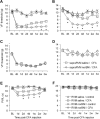Endogenous kappa-opioid receptor systems inhibit hyperalgesia associated with localized peripheral inflammation
- PMID: 18355964
- PMCID: PMC2553515
- DOI: 10.1016/j.pain.2008.01.023
Endogenous kappa-opioid receptor systems inhibit hyperalgesia associated with localized peripheral inflammation
Abstract
Peripheral inflammation evokes functional and biochemical changes in the periphery and spinal cord which result in central sensitization and hypersensitivity. Inhibitory control systems from the rostral ventromedial medulla (RVM) are also activated. The present study investigates whether endogenous kappa-opioid receptor (KOPr) systems contribute to these neuroadaptations. Inflammation was induced by intraplantar injection of complete Freund's adjuvant (CFA) into one hindpaw. Mechanical and thermal thresholds were determined using the Von Frey and radiant heat tests, respectively. KOPr gene deletion in mice or systemic administration of the long-acting KOPr antagonist, norbinaltorphimine (norBNI) significantly exacerbated mechanical and thermal hypersensitivity of the ipsilateral, inflamed paw. Thermal and mechanical thresholds of the non-inflamed, contralateral hindpaw were unaffected by CFA treatment. However, gene deletion as well as norBNI treatment resulted in mechanical, but not thermal hypersensitivity of the non-inflamed paw. Similar results were obtained when norBNI was administered intrathecally or into the RVM in rats. These data demonstrate a previously unrecognized role of endogenous KOPr systems in inhibiting hyperalgesia during inflammation. Furthermore, they demonstrate that decreased KOPr activity in either the spinal cord or RVM not only enhances mechanical and thermal hyperalgesia of the inflamed limb but also leads to an unmasking of mechanical hyperalgesia at a site remote from inflammation. The differential effects of KOPr antagonism on mechanical versus thermal thresholds for the non-inflamed paw support the notion that distinct neuroanatomical or neurochemical mechanisms modulate the processing of thermal versus mechanical stimuli.
Figures








Similar articles
-
Inflammation-induced changes in rostral ventromedial medulla mu and kappa opioid receptor mediated antinociception.Pain. 2008 Jun;136(3):320-330. doi: 10.1016/j.pain.2007.07.010. Epub 2007 Aug 30. Pain. 2008. PMID: 17764840
-
Loss of neurons in rostral ventromedial medulla that express neurokinin-1 receptors decreases the development of hyperalgesia.Neuroscience. 2013 Oct 10;250:151-65. doi: 10.1016/j.neuroscience.2013.06.057. Epub 2013 Jul 3. Neuroscience. 2013. PMID: 23831426 Free PMC article.
-
Rostral ventromedial medulla μ, but not κ, opioid receptors are involved in electroacupuncture anti-hyperalgesia in an inflammatory pain rat model.Brain Res. 2011 Jun 13;1395:38-45. doi: 10.1016/j.brainres.2011.04.037. Epub 2011 Apr 28. Brain Res. 2011. PMID: 21565329 Free PMC article.
-
The analgesic effects of supraspinal mu and delta opioid receptor agonists are potentiated during persistent inflammation.J Neurosci. 2000 Feb 1;20(3):1249-59. doi: 10.1523/JNEUROSCI.20-03-01249.2000. J Neurosci. 2000. PMID: 10648729 Free PMC article.
-
Sustained Suppression of Hyperalgesia during Latent Sensitization by μ-, δ-, and κ-opioid receptors and α2A Adrenergic Receptors: Role of Constitutive Activity.J Neurosci. 2016 Jan 6;36(1):204-21. doi: 10.1523/JNEUROSCI.1751-15.2016. J Neurosci. 2016. PMID: 26740662 Free PMC article.
Cited by
-
Pulsed radiofrequency reduced complete Freund's adjuvant-induced mechanical hyperalgesia via the spinal c-Jun N-terminal kinase pathway.Cell Mol Neurobiol. 2014 Mar;34(2):195-203. doi: 10.1007/s10571-013-0003-z. Epub 2013 Nov 17. Cell Mol Neurobiol. 2014. PMID: 24242210 Free PMC article.
-
Sex differences in kappa opioid pharmacology.Life Sci. 2011 Jan 3;88(1-2):2-16. doi: 10.1016/j.lfs.2010.10.007. Epub 2010 Oct 14. Life Sci. 2011. PMID: 20951148 Free PMC article. Review.
-
Effect of Mas-related gene (Mrg) receptors on hyperalgesia in rats with CFA-induced inflammation via direct and indirect mechanisms.Br J Pharmacol. 2013 Nov;170(5):1027-40. doi: 10.1111/bph.12326. Br J Pharmacol. 2013. PMID: 23909597 Free PMC article.
-
Endogenous analgesia, dependence, and latent pain sensitization.Curr Top Behav Neurosci. 2014;20:283-325. doi: 10.1007/7854_2014_351. Curr Top Behav Neurosci. 2014. PMID: 25227929 Free PMC article.
-
30 years of dynorphins--new insights on their functions in neuropsychiatric diseases.Pharmacol Ther. 2009 Sep;123(3):353-70. doi: 10.1016/j.pharmthera.2009.05.006. Epub 2009 May 28. Pharmacol Ther. 2009. PMID: 19481570 Free PMC article. Review.
References
-
- Antic J, Vasiljevic T, Stanojevic S, Vujic V, Kovacevic-Jovanovic V, Djergovic D, et al. Suppression of adjuvant arthritis by kappa-opioid receptor agonist: effect of route of administration and strain differences. Immunopharmacology. 1996;34:105–12. - PubMed
-
- Bennett AD, Everhart AW, Hulsebosch CE. Intrathecal administration of an NMDA or a non-NMDA receptor antagonist reduces mechanical but not thermal allodynia in a rodent model of chronic central pain after spinal cord injury. Brain Res. 2000;859:72–82. - PubMed
-
- Bilsky EJ, Wang T, Lai J, Porreca F. Selective blockade of peripheral delta opioid agonist induced antinociception by intrathecal administration of delta receptor antisense oligodeoxynucleotide. Neurosci Lett. 1996;220:155–8. - PubMed
-
- Broadbear JH, Negus SS, Butelman ER, de Costa BR, Woods JH. Differential effects of systemically administered nor-binaltorphi-mine (nor-BNI) on kappa-opioid agonists in the mouse writhing assay. Psychopharmacology (Berl) 1994;115:311–9. - PubMed
-
- Butelman ER, Negus SS, Ai Y, de Costa BR, Woods JH. Kappa opioid antagonist effects of systemically administered nor-binaltorphimine in a thermal antinociception assay in rhesus monkeys. J Pharmacol Exp Ther. 1993;267:1269–76. - PubMed
Publication types
MeSH terms
Substances
Grants and funding
LinkOut - more resources
Full Text Sources
Medical

